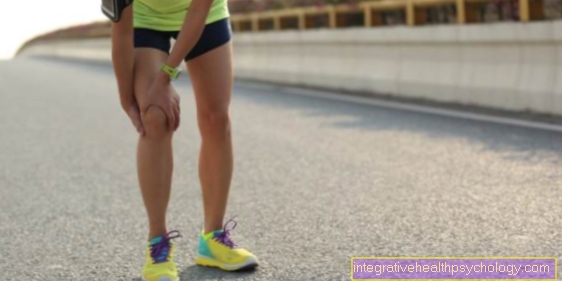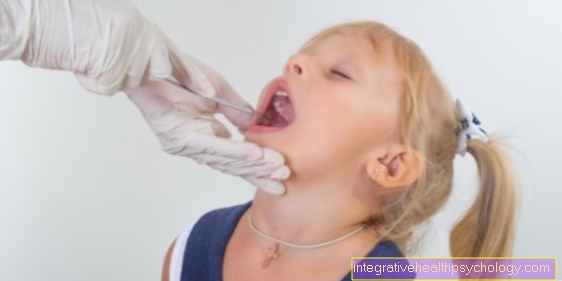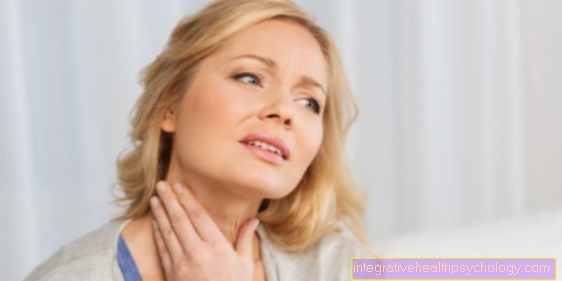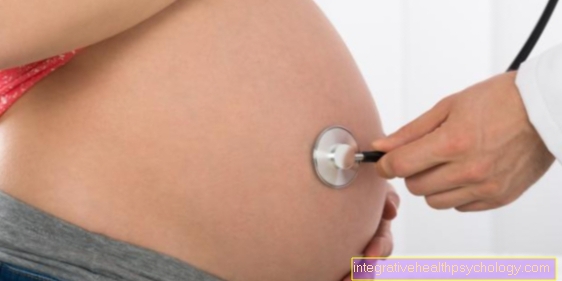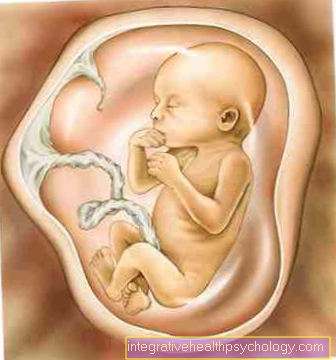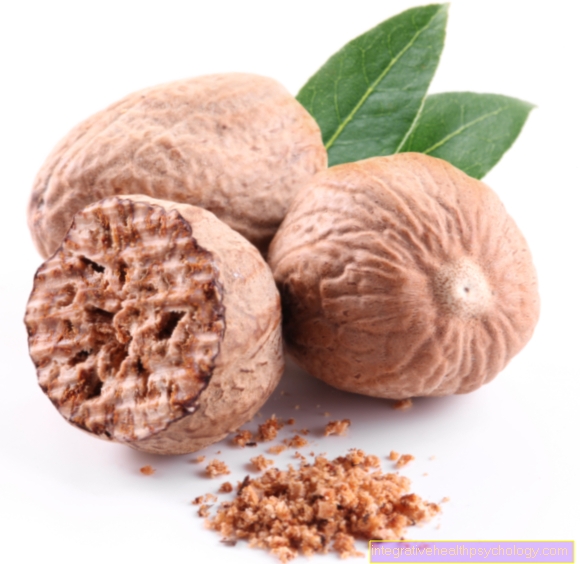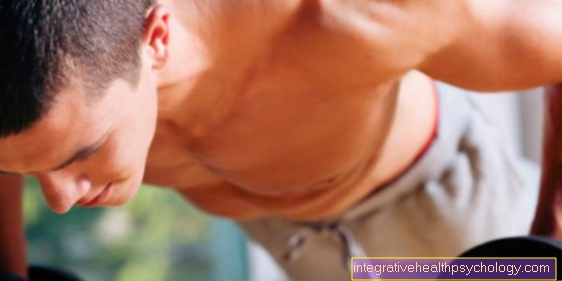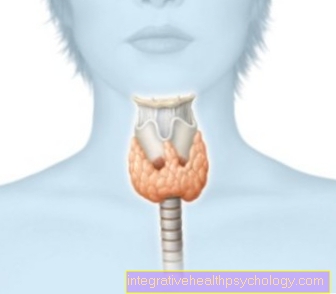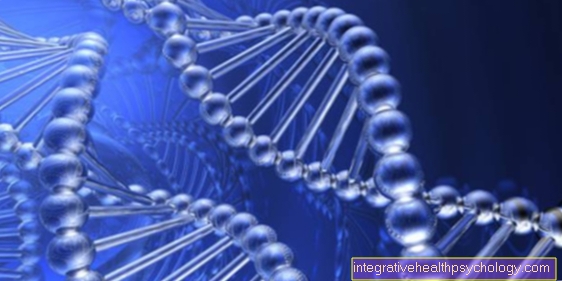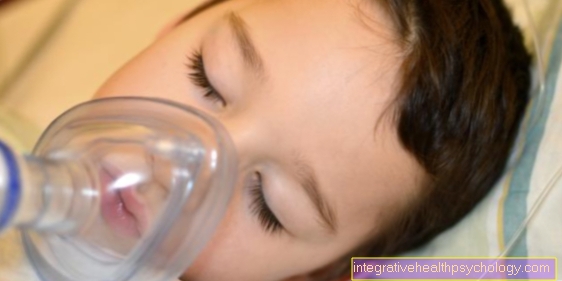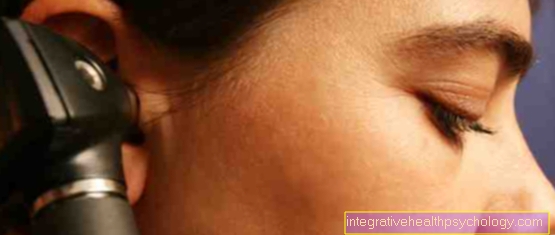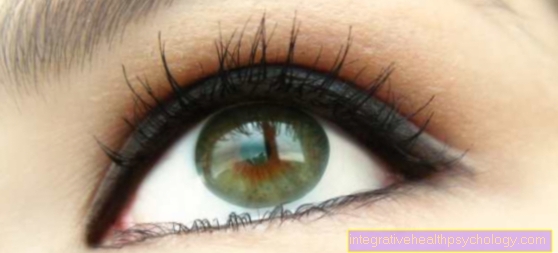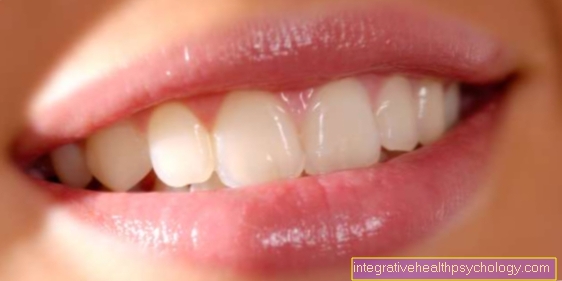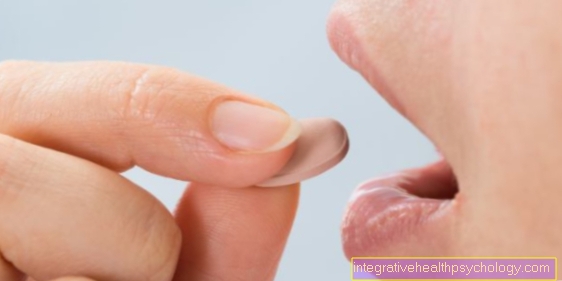arthrosis
Synonyms
Polyarthrosis, ideopathic osteoarthritis, joint wear, cartilage wear, cartilage wear, cartilage wear, chondromalacia (softening of the cartilage), osteoarthritis disease
English: Osteoarthrosis
Medical: Arthrosis deformans
introduction
Arthrosis is a degenerative change in the joints and their appendage tissue. In this context, pain and restricted mobility often occur.
Osteoarthritis usually manifests itself without accompanying inflammatory components.

definition
The term osteoarthritis initially means nothing more than joint disease.
In medicine, on the other hand, osteoarthritis is defined as increasing, age-dependent cartilage wear in the joints of the body.
This cartilage abrasion can occur gradually (latent osteoarthritis) or turn into a painful disease (activated osteoarthritis).
In advanced cases, there are also changes in the area of the bone near the joint, the synovial membrane, the joint capsule and the muscles surrounding the joint. Therefore, osteoarthritis as a clinical picture is not limited to cartilage abrasion alone.
Ultimately, osteoarthritis can lead to the destruction of the joint. The joint then loses its shape. In this case, the term arthrosis deformans is also a common description of the disease.
If osteoarthritis occurs in many joints at the same time, it is known as polyarthrosis.
Occurrence
Everyone can suffer from osteoarthritis sooner or later. The entire human being consists of biological tissue, which is subject to natural wear and tear over the years. In orthopedics, wear-related (degenerative) changes in the joints are in the foreground of the clinical pictures to be treated.
Both men and women are affected. However, there are differences in the frequency of the individual clinical pictures.
The suffering begins insidiously, usually after the age of 50 and progresses in phases. At the beginning the osteoarthritis is usually symptomless, later it manifests itself partly in severe pain.
From an appropriate age, changes in the sense of an arthritic change (joint wear) can be seen in practically all joints.
Interestingly, the amount of cartilage abrasion is not directly related to a patient's complaints. This means that a patient with relatively little cartilage wear can suffer from significantly more pain than a patient with significantly more advanced osteoarthritis.
The reason for this is that the cartilage abrasion as such does not cause pain. Instead, the inflammation of the mucous membranes (synovitis / synovitis) of the joint triggered by the cartilage particles is responsible. This also triggers overheating of the joint and the intra-joint (intra-articular) water formation (joint effusion).
Also read on this topic: Inflammation of the synovial membrane
Any joint can be affected by osteoarthritis.
Most often, however, changes are found in the large, load-bearing joints:
- Hip arthrosis (med. Coxarthrosis),
- Osteoarthritis of the knee (med. Gonarthrosis),
- Spinal osteoarthritis (spondylarthrosis);
Cartilage wear on these joints is of greatest clinical relevance in orthopedics.
Appointment with ?

I would be happy to advise you!
Who am I?
My name is I am a specialist in orthopedics and the founder of .
Various television programs and print media report regularly about my work. On HR television you can see me every 6 weeks live on "Hallo Hessen".
But now enough is indicated ;-)
In order to be able to treat successfully in orthopedics, a thorough examination, diagnosis and a medical history are required.
In our very economic world in particular, there is too little time to thoroughly grasp the complex diseases of orthopedics and thus initiate targeted treatment.
I don't want to join the ranks of "quick knife pullers".
The aim of any treatment is treatment without surgery.
Which therapy achieves the best results in the long term can only be determined after looking at all of the information (Examination, X-ray, ultrasound, MRI, etc.) be assessed.
You will find me:
- - orthopedic surgeons
14
You can make an appointment here.
Unfortunately, it is currently only possible to make an appointment with private health insurers. I hope for your understanding!
For more information about myself, see - Orthopedists.
frequency
The frequency of osteoarthritis increases with age.
In general, the risk is different for each joint.
The most common are found in descending order:
- Facet arthrosis
- Knee osteoarthritis (gonarthrosis)
- Hip osteoarthritis (coxarthrosis)
- Ankle arthrosis
- Big toe joint arthrosis
- Thumb saddle joint osteoarthritis
- Finger osteoarthritis
- other joints.
You can also read the topic Wobenzym from our partner.
causes
Basically, the actual causes that lead to the development of osteoarthritis are still unknown. Nevertheless, some of the previously accepted theories have now been successfully refuted.
Contrary to popular belief, osteoarthritis is not a typical age-related disease. Age is therefore no longer the actual cause, but a decisive risk factor for the development of osteoarthritis. The reason for this is the fact that both the elasticity and the resilience of the Articular cartilage decrease significantly in the course of aging. However, pathological joint changes in the form of osteoarthritis can also be observed more and more frequently in younger people.
It is almost impossible to attribute osteoarthritis to a possible cause. Rather, it is assumed today that this form of degenerative joint disease can be traced back to an interplay of the most varied of factors (causes). The most common causes of osteoarthritis are Injuries and Accidents. About a third of the known cases of osteoarthritis are caused by traumatic causes.
In this context, even the smallest cracks and bumps in the area of the tendons and ligaments are sufficient to negatively influence the cartilage structure.
In addition to the traumatic joint damage, persistent excessive or improper loading is one of the typical causes of osteoarthritis. People who tend to perform certain movements day after day and over a longer period of time, in many cases suffer a significant overload of the joints concerned. In this context osteoarthritis occurs in certain Occupational groups heaped on.
In addition, excessive body weight can lead to chronic overloading of the joints. For this reason it also poses Obesity (Obesity) is one of the typical causes of osteoarthritis.
Furthermore, studies have shown that arthritic changes in the joint structure occur more frequently among family members. A genetic Component (heredity) cannot therefore be ruled out in the development of osteoarthritis. In this context, the structure and structure of the Articular cartilage and the tendency to premature wear of the joints play a decisive role.
Other typical causes for the development of osteoarthritis are various congenital Misalignments the normal axis of the body. A pronounced misalignment can also lead to incorrect or overloading of individual joints. The reason for this is the one-sided physical stress associated with most congenital malpositions.
Since one side of the body usually has to bear significantly more weight in the affected patient, the breakdown of the articular cartilage can be accelerated.
Types of osteoarthritis
- Gonarthrosis of the knee joint
- Coxarthrosis Hip arthrosis
- Omarthrosis shoulder joint arthrosis
- Spondylarthrosis Osteoarthritis of the spine
- Osteoarthritis English term for osteoarthritis
- Herbeden - Arthrosis Arthrosis of the articular joints
- Bouchard - Arthrosis Arthrosis of the median joints
- Rhizarthrosis of the thumb saddle joint arthrosis
- Radiocarpal osteoarthritis of the wrist
- Hallux rigidus osteoarthritis of the metatarsophalangeal joint of the big toe
- Hallux valgus Misalignment of the first toe, which is often combined with osteoarthritis in the metatarsophalangeal joint of the big toe
- Cubital arthrosis Arthrosis of the elbow joint
- Facet arthrosis Arthrosis of the small vertebral joints
- Talocrureal arthrosis ankle arthrosis
A detailed explanation of the special Osteoarthritis form can be found under the respective topic.
Interview with Mein-Allergie-Portal.com: What is the difference between osteoarthritis and arthritis?
On this topic, conducted an interview with mein-allergie-portal.com: "What is the difference between osteoarthritis and arthritis?"
Different forms of osteoarthritis
First of all, one differentiates between a primary form and a secondary form of osteoarthritis.
In primary osteoarthritis, also called idiopathic osteoarthritis, there is no clear cause. Most often, improper stress over the years leads to uneven wear on the joints and thus to pain when moving.
Age is another factor that promotes the occurrence of osteoarthritis.
Genetic factors can also contribute to osteoarthritis coming to light.
In older patients, the finger joints (finger arthrosis) are sometimes also affected. This particular condition is known as Heberden osteoarthritis. The cause is characteristic nodules on the finger joints.
The secondary form of osteoarthritis is characterized by the fact that the cause is known. Frequently, traumas or accidents as well as congenital malpositions are the reason that the joints are worn out unevenly and thus ultimately lead to bone rubbing against bone.
Furthermore, excessive stress on the joints leads to faster wear and tear and the occurrence of osteoarthritis. Construction workers who e.g. work with a jackhammer. The constant vibrations, especially in the joints of the upper extremities (shoulder, fingers, elbow) lead to increased stress and faster wear.
In the recreational sector, bodybuilders and weightlifters are more at risk for osteoarthritis changes in the body. People who are overweight are also at an increased risk of developing osteoarthritis more quickly than thin people. The reason for this is mostly a general bad posture, especially of the legs and knees, which are due to the increased body weight.
Please also read the article: Osteoarthritis and obesity
Patients suffering from rheumatoid arthritis (rheumatism) also suffer from secondary arthrosis. The reason for this lies in a misalignment of the joints, which is caused by severe rheumatism.
Staging of osteoarthritis
After the physical examination, an X-ray of the joint is usually taken, which shows one or more of the typical arthritic changes in advanced osteoarthritis.
These would be a narrowing of the joint space due to the worn out cartilage and the joint surfaces, rubble cysts, osteophytes and sclerotherapy.
These are compensation mechanisms with which the body tries to compensate for the degenerative processes. The osteophytes (bony additions to the joint) are supposed to replace the degenerated bone. Sclerotherapy is a sign of substitute material that, instead of the bone, is supposed to protect the joint and ensure movement. Sclerotherapy is a compression of the bone that occurs because the bone is subjected to excessive mechanical stress. If one or more of these signs can be found on the X-ray, the diagnosis of osteoarthritis can be made.
Osteoarthritis can be divided into different stages based on these characteristics. Stage 1 is a clinically irrelevant osteoarthritis that is only noticeable as such in the X-ray image and is more of an incidental finding.
Stage 2 leads in most cases to a doctor's visit, as the patient feels pain, especially when moving. The joints are not overheated, it is not an inflammatory form.
In stage 3, the articular surfaces and cartilage are already so badly degenerated that permanent pain occurs, which can also occur if no movement is performed.
Read more on the topic: Staging of osteoarthritis
Osteoarthritis pain
The arthritis pain is of a typical character.
So will
- a Starting pain in the morning
- a Pain on the move in the corresponding joints
- and a Exercise pain with repetitive movements
described.
Risk factors

The main risk factors for osteoarthritis include:
- genetic factors (having a common family history of osteoarthritis)
- the body weight
Overweight patients have a much higher risk of osteoarthritis, especially of the knee or hip joints, than light people. The reason is, on the one hand, the higher weight that is placed on the joints and, on the other hand, the incorrect load that results from it.
Please also read the article: Osteoarthritis and obesity
- Extreme athletes (e.g. performance-oriented footballers, skiers)
- Occupational groups who repeatedly perform a special movement that puts stress on the joints also belong to the risk group (e.g. many manual occupations)
- Misalignments of the joints (e.g. knock knees or bow legs)
Read more about this at: Causes of Osteoarthritis
nutrition
One theory of the development of osteoarthritis states that years of poor nutrition and an unhealthy lifestyle have an impact on osteoarthritis.
The consumption of animal proteins, unhealthy fats, grain products (such as baked goods and pasta) and ready-made meals with synthetic food additives are said to promote the development of osteoarthritis due to acidification of the organism.
It is also discussed whether a lack of minerals, abuse of stimulants (e.g. caffeine, alcohol, sugar), severe stress and lack of exercise or incorrect exposure can also trigger osteoarthritis.
A consistent change in diet towards a balanced and comprehensive healthy diet is recommended to alleviate symptoms caused by osteoarthritis.However, even a comprehensive change in diet cannot cure osteoarthritis, as damaged cartilage tissue cannot be restored. Still, diet seems to play an important role.
A healthy diet has a positive effect on the course of osteoarthritis and can even prevent it from developing. Food such as fruit, salads, vegetables, potatoes, brown rice, spelled, millet, skimmed milk products and fish are particularly recommended.
One thesis is that animal fats, as well as sweets, sugar, citrus fruits, coffee, alcohol and black tea should be avoided. Nevertheless, the study situation for the individual foods in osteoarthritis is still very poor and controversial.
A high proportion of leek vegetables, onions and garlic in the diet also had a cartilage-preserving effect.
As with any dietary change, it is also important with regard to osteoarthritis that few ready-made meals are consumed and instead a lot of fresh products are cooked.
In addition, care should be taken to ensure adequate fluid intake, as a lot of fluid leads to increased acid excretion via the kidneys. Neutral drinks such as water should be preferred and soft drinks, lemonades, carbonated or caffeinated and alcoholic drinks should be avoided.
The intake of dietary supplements (such as chondroitin sulfate, certain vitamins or glucosamine) is controversial, but the state of studies on the influence of dietary supplements on osteoarthritis is not yet conclusive.
It is important that an experienced orthopedic surgeon is consulted before a planned attempt to treat osteoarthritis by changing diet or losing weight. The clarification of possible underlying diseases and the exact causes of the osteoarthritis are in the foreground.
Read more on the topic: The right diet for osteoarthritis and the connection between hip osteoarthritis and diet
Therapeutic measures
The treatment measures range from physical therapy and drug measures to surgery.
You can find more detailed information on the subject of osteoarthritis therapy on our website: Osteoarthritis therapy
First of all, the movements that have led to the corresponding incorrect loading of the joint should always be stopped.
Movements that promote osteoarthritis are:
- To ski
- tennis
- Climb
- Football etc.
However, the general avoidance of movement will definitely promote the development of osteoarthritis.
Exercise and exercise in the right amount and reasonable stress are therefore very important and are recommended to prevent osteoarthritis or to alleviate symptoms.
The individually correct form of movement must be found for each patient.
- Running or light jogging
- as well as crawl swimming
- Cross trainer / ergometer
- Cycle
are counted among the joint-gentle sports and recommended. You should move around 30 minutes a day in total.
If necessary, physiotherapists can also be called in, who will demonstrate in patient training which movements are gentle on the joints and how the patient can relieve the corresponding joints.
Regular exercise is particularly advisable for patients who sit a lot. On the one hand, this makes sense because the condition is promoted, on the other hand, because the articular cartilage is adequately supplied with nutrients through sensible movement and thus degenerates less quickly.
Sliding movements with little strain are good for the joints and are recommended, while fast, suddenly stopping movements - such as those found in ball sports - should be avoided.
Furthermore, cooling measures (cryotherapy) can be taken.
Medicines are mostly used in the group of non-steroidal anti-inflammatory drugs (NSAIDs such as ibuprofen or diclofenac). These mainly have an anti-inflammatory effect.
It must be noted, however, that the long-term use of the medication leads to a reduced production of mucus in the stomach and thus an increased risk of gastric bleeding. Therefore the administration of a stomach protector is recommended.
If the drug and physical therapy is of no use or if the osteoarthritis is too advanced, the only therapeutic approach used is surgical treatment.
One of the smaller measures is arthroscopy, the mirroring of the joint. Changes to the cartilage can be remedied by keyhole surgery.
Read more on the topic: Surgery for osteoarthritis
If the damage cannot be repaired with an arthroscopy, artificial joints can help.
As a rule, parts of the joint or the entire joint are removed and replaced with an artificial joint. This procedure has now become a routine procedure in Germany.
After the operation, physical rehabilitation measures that last for weeks or months must be followed so that the patient learns movements again and a corresponding muscle building can take place.
There are newer approaches that focus primarily on the destroyed articular cartilage. There are ways to remove parts of the undamaged cartilage from the joint and insert them into the area that has already been destroyed. This is done on the open joint.
After that, the cartilage has to grow and take over the tasks of the destroyed cartilage. There are also approaches to extract healthy cartilage and grow it outside of the body. Then this is also used again on the destroyed cartilage.
However, the prerequisite for these two procedures is that only the cartilage of the joint is destroyed and the joint surface is still intact.
Read more on the topic: Cartilage transplant
Other modern approaches to osteoarthritis treatment concern daily food consumption. It is assumed that over-acidification of the body is to blame for the formation of osteoarthritis and supports the progression of joint degeneration.
Another way to treat osteoarthritis is to use homeopathic remedies.
Learn more about this at: Homeopathy for osteoarthritis
Summary

Osteoarthritis is the most common joint disease in Germany.
In most cases, the cause of osteoarthritis is an improper load that arises due to a lack of exercise or extreme sports. The degenerative change of the corresponding joint follows.
At first, the articular cartilage becomes thinner, creating small holes that become larger and larger. Finally, the two joint surfaces rub against each other unhindered, which leads to the familiar movement-dependent pain.
In the further course, the bone of the joint surfaces also wears out. As soon as pain occurs, a doctor is usually consulted. The doctor first tries to find out from the medical history what could be the cause of the pain.
On the basis of the joints often affected by osteoarthritis, the suspected diagnosis can be made early on.
In most cases, osteoarthritis occurs in particularly stressed joints. This includes the knee joint, the hip joint, the shoulder joint and the finger joints. The physical exam will show if there is inflammation (overheated, swollen, painful joints).
However, you can only see with certainty how badly a joint has degenerated during an operation on an open joint.
Diet alone cannot prevent or cure osteoarthritis. However, the importance of regular hyperacidity through the diet has recently become more and more important.
Arthrosis occurs much more frequently in western countries than in developing countries, although it can be assumed that the population there puts much more strain on the joints than in western countries.
It is therefore assumed that the combination of lack of exercise and sudden overload (extreme sport) are among the main factors causing osteoarthritis. In addition, incorrect loads (too frequent and incorrect sitting and moving) are the main causes of osteoarthritis.

